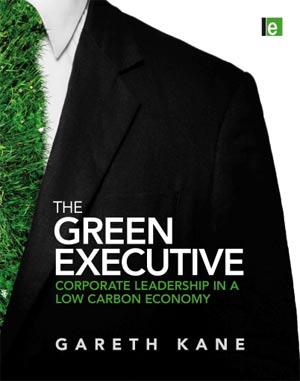 Normally you would expect a book review to come at or around the time of a book’s publication. That was my most sincere intention when The Green Executive’s author, Gareth Kane of Terra Infirma, sent me a pre publication PDF back in May 2011.
Normally you would expect a book review to come at or around the time of a book’s publication. That was my most sincere intention when The Green Executive’s author, Gareth Kane of Terra Infirma, sent me a pre publication PDF back in May 2011.
Crumbs, was it really May? How time has marched on since then!
To try and make up for the terrible slip in the space-time continuum I will quite honestly put the one word out there which deserves to describe The Green Executive: fantastic!
From introducing why business must change…
The book is spit into four main parts: Why Do It?, The Global Context, Practical Action, and Making It Happen. These embrace 18 chapters and over 260 pages. In addition each chapter is neatly spliced into subsections and has a brief summary of key points at the end. Coupled with Gareth Kane’s easy writing style this makes the book very easily digestible.
The first two parts of the book describe why businesses need to change from the “as usual” model where high profits are king. The business imperatives behind this are likely as not well known to readers of this blog: that regulation will continue to tighten and that properly implemented green policies are often, in fact, cheaper than current practices.
However, the book also tackles those areas which other books tend to shy away from. This includes the sticky area of ethics and also the manifest risks businesses make by nailing their green colours to their commercial mast. These are both areas executives need to understand fully and yet they are rarely as well thought through as (say) green marketing initiatives.
The book also puts the case for green business in the global context very neatly. At the heart of this is the need to recognise that we all interact with one another on a truly global scale. This may seem obvious but it’s because we’ve ignored this interconnectedness that such huge problems such as climate change and cumulative persistent toxicity have come about.
So being a green executive is all about thining globally as well as locally, thinking environmentally and socially as well as commercially.
… to introducing that change, even in a subversive way
It’s very interesting to note how Gareth Kane approaches the issue of ethics, as mentioned above. Effectively he’s describing someone whose conviction is that business should be run along green lines, rather than a businessman who hears about this new “green” thing and wonders if they can exploit it.
This is why the next two sections, introducing the practical changes which can make a business more sustainable and how these changes can be put into action, are so very important.
These sections don’t just outline in simple and practical language how to go about greening a supply chain or introducing environmental management systems. They also look at how to do this within an existing business context where there may be resistance to going green.
For example, Gareth Kane cites the martial art of jujitsu and talks about “green jujitsu” … the art of using a business opponent’s strength against themself. He also draws a clear line between managers and leaders. Managers imitate and rely on control, leaders innovate and inspire trust.
The message is simple and exact. Green businessmen, even those at the top of their organisations, have to be prepared to fight for the transformation they want to see in the business. They have to be leaders, not managers.
The Green Executive of 2012
For a number of reasons I had my head down for most of the second half of 2011 and didn’t really pay much attention to what was going on in the rest of the world. Emerging as I am now from this self imposed state I find a lot of business sustainability types are rather gloomy about 2012.
I’m not entirely sure why this is, though perhaps the continuing scarcity of finance means green budgets and programmes are being slashed left, right and centre.
However I’ve long seen 2012 as being a difficult year, but for a different reason. Until now sustainability has happened because of the exuberance of a few high profile business leaders and the fact it has brought a host of cost savings to the business-as-usual model.
This, however, is the year when it will start to get properly meaningful and sustainability will start to be seen as a the new business model that it truly.
In other words, this is when it starts to get hard, and I can think of no better handbook for a Green Executive or aspiring green business leader to have to hand than this one.
A former CTO, Chris has a broad and varied background. He’s been involved with blue chips, consultancies & SMEs across a wide variety of sectors and has worked in Europe, the Middle East and Australia.
In 2007 he decided to combine his knowledge of business and IT with his passion for all things sustainable and has been busy writing ever since. However, his greatest ambition remains to brew the perfect cup of coffee.
